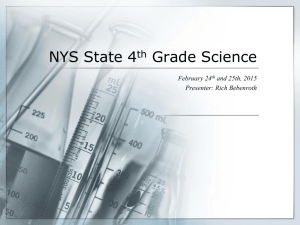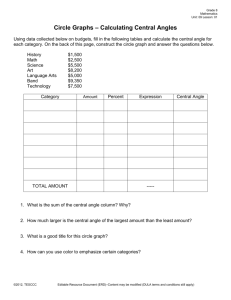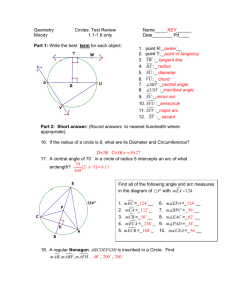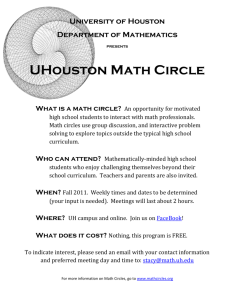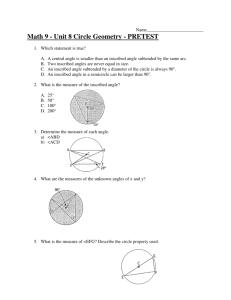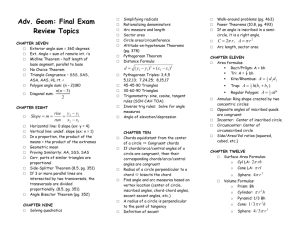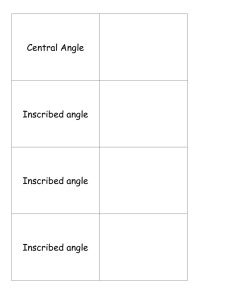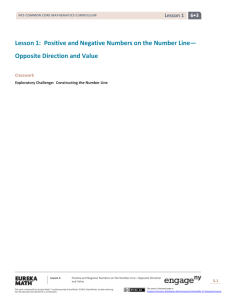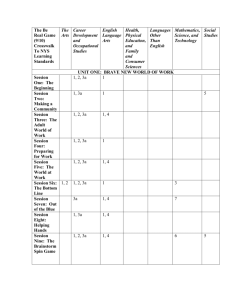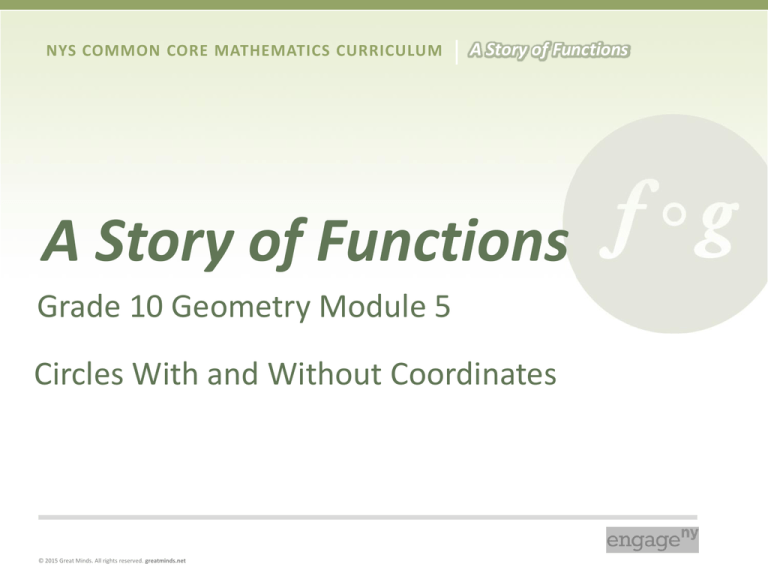
NYS COMMON CORE MATHEMATICS CURRICULUM
A Story of Functions
A Story of Functions
Grade 10 Geometry Module 5
Circles With and Without Coordinates
© 2015 Great Minds. All rights reserved. greatminds.net
NYS COMMON CORE MATHEMATICS CURRICULUM
Participant Poll
•
•
•
•
•
Classroom teacher
Math trainer or coach
Principal or school leader
District representative / leader
Other
© 2015 Great Minds. All rights reserved. greatminds.net
A Story of Functions
NYS COMMON CORE MATHEMATICS CURRICULUM
A Story of Functions
Session Objectives
•
Participants will understand the development of
mathematical concepts surrounding circles and line
segments that intersect circles.
•
Participants will enrich their knowledge and experience
in order to implement Module 5 with confidence and
success.
© 2015 Great Minds. All rights reserved. greatminds.net
NYS COMMON CORE MATHEMATICS CURRICULUM
A Story of Functions
Agenda
• Session 1
• Module Overview and Topic A
• Session 2
• Complete Topic A and begin Topic B
• Session 3
• Complete Topic B and the Mid-Module-Assessment
• Session 4
• Topics C and D
• Session 5
• Complete Topics D, E, and the End-of-Module Assessment
© 2015 Great Minds. All rights reserved. greatminds.net
NYS COMMON CORE MATHEMATICS CURRICULUM
A Story of Functions
Module 5: Circles With and Without Coordinates
This module is allotted 25 instructional days.
• Topic A: Central and Inscribed Angles (G-C.A.2, G-C.A.3)
• Topic B: Arcs and Sectors (G-C.A.1, G-C.A.2, G-C.B.5)
• Topic C: Secants and Tangents (G-C.A.2, G-C.A.3)
• Topic D: Equations for Circles and Their Tangents (G-GPE.A.1, G-GPE.B.4)
• Topic E: Cyclic Quadrilaterals and Ptolemy’s Theorem (G-C.A.3)
© 2015 Great Minds. All rights reserved. greatminds.net
NYS COMMON CORE MATHEMATICS CURRICULUM
A Story of Functions
Module 5: Circles With and Without Coordinates
Topic A: Central and Inscribed Angles (6 lessons)
• Thales’ theorem, general inscribed-central angle theorem
• Students solve unknown angle problems.
• Students inscribe triangles and rectangles in circles and study their properties.
Topic B: Arcs and Sectors (4 lessons)
• Relationships between chords, diameters, and angles are established.
• Students develop a formula for arc length and area of a sector.
• Students practice their skills by solving unknown area problems.
Mid-Module Assessment (2 days)
© 2015 Great Minds. All rights reserved. greatminds.net
NYS COMMON CORE MATHEMATICS CURRICULUM
A Story of Functions
Module 5: Circles With and Without Coordinates
Topic C: Secants and Tangents (6 lessons)
• Secant angle theorems, tangent-secant angle theorems.
• Students explore relationships in diagrams of secant and tangent lines.
• Students use similar triangles to discover length relationships in diagrams.
Topic D: Equations for Circles and Their Tangents (3 lessons)
• Students develop the equation for a circle using the Pythagorean theorem and
translation.
Topic E: Cyclic Quadrilaterals and Ptolemy’s Theorem (2 lessons)
• Focus on properties of quadrilaterals inscribed in circles.
• Bring together congruence and similarity, the Pythagorean theorem, facts about
triangles, and trigonometry.
End-of-Module Assessment (2 days)
© 2015 Great Minds. All rights reserved. greatminds.net
NYS COMMON CORE MATHEMATICS CURRICULUM
A Story of Functions
Topic A: Central and Inscribed Angles
Standards
•
G-C.A.2, G-C.A.3: Identify and describe relationships among inscribed
angles, radii, and chords, construct inscribed and circumscribed circles of
a triangle, and prove properties of angles for inscribed quadrilaterals.
Key Concepts
•
Thales’ theorem, inscribed angles, an inscribed right angle subtends the
arc of a semicircle, the measure of an inscribed angle is half the measure
of the central angle that subtends the same arc, inscribed angles that
subtend the same arc have equal measures.
© 2015 Great Minds. All rights reserved. greatminds.net
NYS COMMON CORE MATHEMATICS CURRICULUM
A Story of Functions
Topic A: Central and Inscribed Angles
Lesson 1:
Lesson 2:
Lesson 3:
Lesson 4:
Lesson 5:
Lesson 6:
Thales’ Theorem
Circles, Chords, Diameter, and Their Relationships
Rectangles Inscribed in Circles
Experiments with Inscribed Angles
Inscribed Angle Theorem and Its Applications
Unknown Angle Problems with Inscribed Angles in
Circles
© 2015 Great Minds. All rights reserved. greatminds.net
NYS COMMON CORE MATHEMATICS CURRICULUM
A Story of Functions
Lesson 1: Thales’ Theorem
• Using observations from a pushing puzzle, students explore
the converse of Thales’ theorem: If triangle ABC is a right
triangle, then A, B, and C are three distinct points on a circle
with a diameter 𝐴𝐵.
• Students prove the statement of Thales’ theorem: If A, B, and
C are three different points on a circle with a diameter 𝐴𝐵
then angle ABC is a right angle.
© 2015 Great Minds. All rights reserved. greatminds.net
NYS COMMON CORE MATHEMATICS CURRICULUM
A Story of Functions
Opening Exercise
Paper “push” a right angle between two fixed points to find
points on a circle.
•
•
•
•
What curve is traced?
Where is the center of the semicircle?
What is the radius?
Can we prove that all of the points (C, D, E…)
lie on the circle?
Lesson 1
© 2015 Great Minds. All rights reserved. greatminds.net
NYS COMMON CORE MATHEMATICS CURRICULUM
Exploratory Challenge
Lesson 1
© 2015 Great Minds. All rights reserved. greatminds.net
A Story of Functions
NYS COMMON CORE MATHEMATICS CURRICULUM
A Story of Functions
Example 1: Proving Thales’ Theorem
Draw circle P with distinct points A, B, and C on the circle and diameter 𝐴𝐵.
Prove that ∠𝐴𝐶𝐵 is a right angle.
Lesson 1
© 2015 Great Minds. All rights reserved. greatminds.net
NYS COMMON CORE MATHEMATICS CURRICULUM
Exercise 2
Lesson 1
© 2015 Great Minds. All rights reserved. greatminds.net
A Story of Functions
NYS COMMON CORE MATHEMATICS CURRICULUM
A Story of Functions
Lesson 2: Circles, Chords, Diameters and Their
Relationships
• Students identify the relationships between the diameters of a circle and
other chords of the circle.
© 2015 Great Minds. All rights reserved. greatminds.net
NYS COMMON CORE MATHEMATICS CURRICULUM
A Story of Functions
Opening Exercise and Discussion
Given 𝐴𝐵, construct its perpendicular bisector.
Draw a different line bisecting segment 𝐴𝐵.
What are some similarities and differences of the bisectors?
Draw
a circle of: any
radius
Draw a chord
circle and
EQUIDISTANT
A point
𝐴 isand
saidcenter
to be 𝑃.
equidistant
from on
twothe
different
label
its endpoints
and=𝐵.𝐴𝐶.
points
𝐵 and 𝐶 if𝐴𝐴𝐵
Construct
perpendicular
bisector
of chord
𝐴𝐵. above with other
Points 𝐵the
and
𝐶 can be replaced
in the
definition
What
do you
observe?
figures
(lines,
etc.) as long as the distance to the figures is given
Draw
chord 𝐶𝐷
andwe
construct
thethe distance from the
meaning
first.onInthe
thiscircle
lesson,
will define
perpendicular
bisector
chord This
𝐶𝐷. definition
What do you
center of a circle
to aofchord.
will allow us to talk about
observe?
the center of a circle as being equidistant from two chords.
Lesson 2
© 2015 Great Minds. All rights reserved. greatminds.net
NYS COMMON CORE MATHEMATICS CURRICULUM
A Story of Functions
Students prove in groups…
1.
2.
3.
4.
5.
6.
If a diameter of a circle bisects a chord, then it must be perpendicular to
the chord.
If a diameter of a circle is perpendicular to a chord, then it bisects the
chord.
In a circle, if two chords are congruent, then the center of
the circle is equidistant from the two chords.
In a circle, if two chords are equidistant from the center,
then the two chords are congruent.
In a circle, congruent chords define central angles that
are equal in measure.
In a circle, if two chords define central angles that are
equal in measure, then they are congruent.
Lesson 2
© 2015 Great Minds. All rights reserved. greatminds.net
NYS COMMON CORE MATHEMATICS CURRICULUM
A Story of Functions
Lesson 3: Rectangles Inscribed in Circles
• Students inscribe a rectangle in a circle.
• Students understand the symmetries of inscribed rectangles
across a diameter.
© 2015 Great Minds. All rights reserved. greatminds.net
NYS COMMON CORE MATHEMATICS CURRICULUM
A Story of Functions
Opening Exercise
Using only a compass and straight edge, follow the steps below to
find the center of a given circle.
Lesson 3
© 2015 Great Minds. All rights reserved. greatminds.net
NYS COMMON CORE MATHEMATICS CURRICULUM
A Story of Functions
Exploratory Challenge
Construct a rectangle that is inscribed in a given circle.
• How can we use the
construction in the Opening
Exercise to accomplish this goal?
• What do we know about the
properties of rectangles?
Lesson 3
© 2015 Great Minds. All rights reserved. greatminds.net
NYS COMMON CORE MATHEMATICS CURRICULUM
A Story of Functions
Exploratory Challenge
Construct a rectangle that is inscribed in a given circle.
Strategy #1:
• We know that the diagonals of a rectangle
are equal in length and bisect each other.
• The diameters/hypotenuses satisfy this
criteria so their endpoints are the vertices of
an inscribed rectangle.
Lesson 3
© 2015 Great Minds. All rights reserved. greatminds.net
NYS COMMON CORE MATHEMATICS CURRICULUM
A Story of Functions
Exploratory Challenge
Construct a rectangle that is inscribed in a given circle.
Strategy #2:
• A rectangle is composed of two congruent
right triangles. A congruence consisting of a
180˚ rotation about the midpoint of the
hypotenuse maps one triangle onto the
other.
• Rotate one of your triangles about the
center of the circle 180˚.
Students may find alternative strategies.
Lesson 3
© 2015 Great Minds. All rights reserved. greatminds.net
NYS COMMON CORE MATHEMATICS CURRICULUM
A Story of Functions
Exercises 1 – 5
Take a moment to review exercises 1 – 5. It is in these exercises
that students consider the symmetries on inscribed rectangles
across a diameter.
• Note that Exercise 5 is a challenge and can
either be assigned to advanced learners or
covered as a teacher-led example.
Lesson 3
© 2015 Great Minds. All rights reserved. greatminds.net
NYS COMMON CORE MATHEMATICS CURRICULUM
A Story of Functions
Lesson 4: Experiments with Inscribed Angles
• Students explore the relationship between inscribed angles and central
angles and their intercepted arcs.
© 2015 Great Minds. All rights reserved. greatminds.net
NYS COMMON CORE MATHEMATICS CURRICULUM
Exploratory Challenges 1-4
1.
2.
3.
4.
Paper pushing exercise.
Paper pushing exercise.
Comparing inscribed angles.
Comparing inscribed angles to a central angle.
Lesson 4
© 2015 Great Minds. All rights reserved. greatminds.net
A Story of Functions
NYS COMMON CORE MATHEMATICS CURRICULUM
A Story of Functions
Lesson 5: Inscribed Angle Theorem and Its
Applications
• Students prove the inscribed angle theorem: The measure of a central
angle is twice the measure of any inscribed angle that intercepts the same
arc as the central angle.
• Students recognize and use different cases of the inscribed angle theorem
embedded in diagrams. This includes recognizing and using the result that
inscribed angles that intersect the same arc are equal in measure.
This lesson covers only part of the Inscribed Angle Theorem –
The Central Angle version. The case for a central angle whose
measure is greater than 180 degrees is left for lesson 7.
© 2015 Great Minds. All rights reserved. greatminds.net
NYS COMMON CORE MATHEMATICS CURRICULUM
Opening Exercises
Lesson 5
© 2015 Great Minds. All rights reserved. greatminds.net
A Story of Functions
NYS COMMON CORE MATHEMATICS CURRICULUM
A Story of Functions
Examples 1 and 2
Based on our observation from the Opening Exercise, the
following theorem can be developed:
Theorem: The measure of a central angle is twice the measure of any
inscribed angle that intercepts the same arc as the central angle.
Case 1: The vertex of the central angle lies on a
side of the inscribed angle.
This was proven in the Opening Exercise.
Lesson 5
© 2015 Great Minds. All rights reserved. greatminds.net
NYS COMMON CORE MATHEMATICS CURRICULUM
A Story of Functions
Examples 1 and 2
Based on our observation from the Opening Exercise, the
following theorem can be developed:
THEOREM: The measure of a central angle is twice the measure of any inscribed
angle that intercepts the same arc as the central angle.
Case 2: The vertex of the central angle lies in the
interior of the inscribed angle.
Case 3: The vertex of the central angle lies in the
exterior of the inscribed angle.
Lesson 5
© 2015 Great Minds. All rights reserved. greatminds.net
NYS COMMON CORE MATHEMATICS CURRICULUM
A Story of Functions
Lesson 6: Unknown Angle Problems with
Inscribed Angles in Circles
• Students use the inscribed angle theorem to find the measures of unknown
angles.
• Students prove relationships between inscribed angles and central angles.
© 2015 Great Minds. All rights reserved. greatminds.net
NYS COMMON CORE MATHEMATICS CURRICULUM
A Story of Functions
Opening Exercise
In a circle, a chord 𝐷𝐸 and a diameter 𝐴𝐵 are extended outside of the circle to
meet at a point 𝐶. If 𝑚∠𝐷𝐴𝐸 = 46°, and 𝑚∠𝐷𝐶𝐴 = 32°, find 𝑚∠𝐷𝐸𝐴.
Lesson 6
© 2015 Great Minds. All rights reserved. greatminds.net
NYS COMMON CORE MATHEMATICS CURRICULUM
A Story of Functions
Exploratory Challenge
THEOREM: If 𝐴, 𝐵, 𝐵′ , and 𝐶 are four points with 𝐵 and 𝐵′ on the same side of
line 𝐴𝐶, and ∠𝐴𝐵𝐶 and ∠𝐴𝐵′ 𝐶 are congruent, then 𝐴, 𝐵, 𝐵′, and 𝐶 all lie on
the same circle.
Lesson 6
© 2015 Great Minds. All rights reserved. greatminds.net
NYS COMMON CORE MATHEMATICS CURRICULUM
A Story of Functions
Exploratory Challenge
THEOREM: If 𝐴, 𝐵, 𝐵′ , and 𝐶 are four points with 𝐵 and 𝐵′ on the same side of
line 𝐴𝐶, and ∠𝐴𝐵𝐶 and ∠𝐴𝐵′ 𝐶 are congruent, then 𝐴, 𝐵, 𝐵′, and 𝐶 all lie on
the same circle.
First let’s consider the case where 𝐵′ is
outside the circle.
Label the intersection of 𝐴𝐵′ and the circle
point 𝑃. Angles 𝐴𝐵𝐶 and 𝐴𝑃𝐶 are inscribed
angles that intercept the same arc, so both
angles have the same measure, 𝑥°.
Lesson 6
© 2015 Great Minds. All rights reserved. greatminds.net
NYS COMMON CORE MATHEMATICS CURRICULUM
A Story of Functions
Exploratory Challenge
THEOREM: If 𝐴, 𝐵, 𝐵′ , and 𝐶 are four points with 𝐵 and 𝐵′ on the same side of
line 𝐴𝐶, and ∠𝐴𝐵𝐶 and ∠𝐴𝐵′ 𝐶 are congruent, then 𝐴, 𝐵, 𝐵′, and 𝐶 all lie on
the same circle.
Angle 𝑃𝐶𝐵′ in triangle 𝑃𝐶𝐵′ has degree
measure 𝑐 > 0. By the exterior angle
theorem, ∠𝐴𝑃𝐶 = ∠𝑃𝐵′ 𝐶 + ∠𝑃𝐶𝐵′.
Using substitution, 𝑥 = 𝑥 + 𝑐. However
since 𝑐 > 0, this is a contradiction, so 𝐵′
cannot lie outside the circle.
Lesson 6
© 2015 Great Minds. All rights reserved. greatminds.net
NYS COMMON CORE MATHEMATICS CURRICULUM
A Story of Functions
Exploratory Challenge
THEOREM: If 𝐴, 𝐵, 𝐵′ , and 𝐶 are four points with 𝐵 and 𝐵′ on the same side of
line 𝐴𝐶, and ∠𝐴𝐵𝐶 and ∠𝐴𝐵′ 𝐶 are congruent, then 𝐴, 𝐵, 𝐵′, and 𝐶 all lie on
the same circle.
Next let’s consider the case where 𝐵′ lies in
the interior of the circle.
Extend 𝐴𝐵′ and marks its intersection with
the circle 𝑃. Angles 𝐴𝐵𝐶 and 𝐴𝑃𝐶 are both
inscribed angles that intercept the same arc,
so their measures are equal, 𝑥°.
Lesson 6
© 2015 Great Minds. All rights reserved. greatminds.net
NYS COMMON CORE MATHEMATICS CURRICULUM
A Story of Functions
Exploratory Challenge
THEOREM: If 𝐴, 𝐵, 𝐵′ , and 𝐶 are four points with 𝐵 and 𝐵′ on the same side of
line 𝐴𝐶, and ∠𝐴𝐵𝐶 and ∠𝐴𝐵′ 𝐶 are congruent, then 𝐴, 𝐵, 𝐵′, and 𝐶 all lie on
the same circle.
In triangle 𝐵′ 𝐶𝑃, angle 𝐵′ 𝐶𝑃 has degree
measure 𝑐 > 0. Using the exterior angle
theorem, ∠𝐴𝐵′ 𝐶 = ∠𝐵′ 𝑃𝐶 + ∠𝐵′ 𝐶𝑃.
Using substitution, 𝑥 = 𝑥 + 𝑐. However since
𝑐 > 0, this is a contradiction, so 𝐵′ cannot lie in
the circle.
Since 𝐵′ cannot lie outside the circle, nor can it
lie inside the circle, 𝐵′ must lie on the circle,
and thus, the theorem is proved.
Lesson 6
© 2015 Great Minds. All rights reserved. greatminds.net
NYS COMMON CORE MATHEMATICS CURRICULUM
A Story of Functions
Topic B: Arcs and Sectors
Standards
•
G-C.A.1, G-C.A.2, G-C.B.5: Prove that all circles are similar, identify and
describe relationships among inscribed angles, radii, and chords. Use
similarity to define arc length, define radian measure, derive area
formula for sectors.
Key Concepts
•
•
Properties of congruence, similarity, and isosceles triangles are applied
to proofs; congruent chords lie in congruent arcs, all circles are similar.
Students extend the protractor axiom (angles add) to arcs.
© 2015 Great Minds. All rights reserved. greatminds.net
NYS COMMON CORE MATHEMATICS CURRICULUM
Topic B: Arcs and Sectors
Lesson 7: The Angle Measure of an Arc
Lesson 8: Arcs and Chords
Lesson 9: Arc Length and Area of Sectors
Lesson 10: Unknown Length and Area Problems
© 2015 Great Minds. All rights reserved. greatminds.net
A Story of Functions
NYS COMMON CORE MATHEMATICS CURRICULUM
A Story of Functions
Lesson 7: The Angle Measure of an Arc
• Define the angle measure of arcs, and understand that arcs of
equal angle measure are similar.
• Restate and understand the inscribed angle theorem in terms
of arcs: The measure of an inscribed angle is half the angle
measure of its intercepted arc.
• Only in this lesson is the theorem stated in full:
The measure of an inscribed angle is half the angle measure of its
intercepted arc.
• Explain and understand that all circles are similar.
© 2015 Great Minds. All rights reserved. greatminds.net
NYS COMMON CORE MATHEMATICS CURRICULUM
A Story of Functions
Discussion and Example 1: Jigsaw
Think about how you would deliver the content in the discussion/example in
your classroom. Be prepared to share key points and instructional tips with
the whole group (2 – 3 min per part).
Group 1:
Group 2:
Group 3:
Group 4:
Part 1 of Discussion
Part 2 of Discussion
Part 3 of Discussion
Example 1
Lesson 7
© 2015 Great Minds. All rights reserved. greatminds.net
NYS COMMON CORE MATHEMATICS CURRICULUM
A Story of Functions
Lesson 8: Arcs and Chords
• Students know that congruent chords have congruent arcs, and that the
converse is also true.
• Students know that arcs between parallel chords are congruent.
© 2015 Great Minds. All rights reserved. greatminds.net
NYS COMMON CORE MATHEMATICS CURRICULUM
Exploratory Challenge
Prove that congruent chords have congruent arcs.
Lesson 8
© 2015 Great Minds. All rights reserved. greatminds.net
A Story of Functions
NYS COMMON CORE MATHEMATICS CURRICULUM
A Story of Functions
Example 1
THEOREM: In a circle, arcs between parallel chords are congruent.
Prove this theorem in two ways.
Lesson 8
© 2015 Great Minds. All rights reserved. greatminds.net
NYS COMMON CORE MATHEMATICS CURRICULUM
A Story of Functions
Lesson 9: Arc Length and Area of Sectors
• When students are provided with the angle measure of the arc and the
length of the radius of the circle, they understand how to determine the
length of an arc and the area of a sector.
ARC: An arc is any of the following three figures—a minor arc, a major arc, or a semicircle.
LENGTH OF AN ARC: The length of an arc is the circular distance around the arc.
MINOR AND MAJOR ARC: In a circle with center O, let A and B be different points that lie on the circle but are
not the endpoints of a diameter. The minor arc between A and B is the set containing A, B, and all points of
the circle that are in the interior of ∠AOB. The major arc is the set containing A, B, and all points of the
circle that lie in the exterior of ∠AOB.
RADIAN: A radian is the measure of the central angle of a sector of a circle with arc length of one radius
length.
SECTOR: Let AB be an arc of a circle with center O and radius r. The union of the segments OP, where P is
any point on the AB, is called a sector. AB is called the arc of the sector, and r is called its radius.
SEMICIRCLE: In a circle, let A and B be the endpoints of a diameter. A semicircle is the set containing A, B, and
all points of the circle that lie in a given half-plane of the line determined by the diameter.
© 2015 Great Minds. All rights reserved. greatminds.net
NYS COMMON CORE MATHEMATICS CURRICULUM
Example 1
Lesson 9
© 2015 Great Minds. All rights reserved. greatminds.net
A Story of Functions
NYS COMMON CORE MATHEMATICS CURRICULUM
Example 1: Discussion
Lesson 9
© 2015 Great Minds. All rights reserved. greatminds.net
A Story of Functions
NYS COMMON CORE MATHEMATICS CURRICULUM
Example 1: Discussion
Lesson 9
© 2015 Great Minds. All rights reserved. greatminds.net
A Story of Functions
NYS COMMON CORE MATHEMATICS CURRICULUM
Example 2
In this example, the formula to find the area of a sector is developed.
Lesson 9
© 2015 Great Minds. All rights reserved. greatminds.net
A Story of Functions
NYS COMMON CORE MATHEMATICS CURRICULUM
A Story of Functions
Lesson 10: Unknown Length and Area Problems
• Students apply their understanding of arc length and area of sectors to
solve problems of unknown length and area.
© 2015 Great Minds. All rights reserved. greatminds.net
NYS COMMON CORE MATHEMATICS CURRICULUM
A Story of Functions
Opening Exercise
In the following figure, a cylinder is carved out from within another cylinder of
the same height; the bases of both cylinders share the same center.
a. Sketch a cross section of the figure parallel to the base.
This figure is referred
to as an annulus.
Lesson 10
© 2015 Great Minds. All rights reserved. greatminds.net
NYS COMMON CORE MATHEMATICS CURRICULUM
A Story of Functions
Opening Exercise
In the following figure, a cylinder is carved out from within another cylinder of
the same height; the bases of both cylinders share the same center.
b. Mark and label the shorter of the two radii as 𝑟 and the longer 𝑠. Show how
to calculate the area of the shaded region, and explain the parts of the
expression.
Lesson 10
© 2015 Great Minds. All rights reserved. greatminds.net
NYS COMMON CORE MATHEMATICS CURRICULUM
A Story of Functions
Exercises 1-13
• Take a few minutes to review and complete some of the exercises in this
lesson.
• The problems vary in level of difficulty and can be used to differentiate in
your classroom.
Lesson 10
© 2015 Great Minds. All rights reserved. greatminds.net
NYS COMMON CORE MATHEMATICS CURRICULUM
A Story of Functions
Mid-Module Assessment
• Take a few moments to review the problems provided on the Mid-Module
Assessment Task.
• Choose one problem to complete in its entirety.
• Compare your response to the provided sample work.
• Compare your response to the Mastery Rubric.
• What student response(s) would demonstrate STEP 1 in mastery?
• STEP 2?
• STEP 3?
• STEP 4?
• Where do you feel your response lies?
© 2015 Great Minds. All rights reserved. greatminds.net
NYS COMMON CORE MATHEMATICS CURRICULUM
A Story of Functions
Topic C: Secants and Tangents
Standards
•
G-C.A.2, G-C.A.3: Identify and describe relationships among inscribed
angles, radii, and chords. Construct the inscribed and circumscribed
circles of a triangle, prove properties of angles for an inscribed
quadrilateral.
Key Concepts
•
Students continue to use properties of congruence and triangles in
general to describe relationships formed by tangent and secant lines
while incorporating recent knowledge related to inscribed angles and
intercepted arcs.
© 2015 Great Minds. All rights reserved. greatminds.net
NYS COMMON CORE MATHEMATICS CURRICULUM
A Story of Functions
Topic C: Secants and Tangents
Lesson 11:
Lesson 12:
Lesson 13:
Lesson 14:
Lesson 15:
Lesson 16:
Properties of Tangents
Tangent Segments
The Inscribed Angle Alternate – A Tangent Angle
Secant Lines; Secant Lines That Meet Inside a Circle
Secant Angle Theorem, Exterior Case
Similar Triangles in Circle-Secant (or Circle-SecantTangent) Diagrams.
© 2015 Great Minds. All rights reserved. greatminds.net
NYS COMMON CORE MATHEMATICS CURRICULUM
A Story of Functions
Lesson 11: Properties of Tangents
• Students discover that a line is tangent to a circle at a given point if it is
perpendicular to the radius drawn to that point.
• Students construct tangents to a circle through a given point.
• Students prove that tangent segments from the same point are equal in
length.
© 2015 Great Minds. All rights reserved. greatminds.net
NYS COMMON CORE MATHEMATICS CURRICULUM
A Story of Functions
Opening
• Sets the stage for Topic C and presents the vocabulary secant line, tangent
line and tangent segment.
• Students draw a circle and line, teacher groups drawings and discusses.
Lesson 11
© 2015 Great Minds. All rights reserved. greatminds.net
NYS COMMON CORE MATHEMATICS CURRICULUM
A Story of Functions
Exploratory Challenge
• Students draw a circle and a tangent line and note the point of tangency as P.
• Draw a circle and a radius intersecting the circle at a point P.
• Construct a line through P, perpendicular to the radius.
• Students measure the angle formed by
the radius and tangent and compare
findings with neighbors.
• A tangent line to a circle is perpendicular
to the radius of the circle drawn to the
point of tangency.
• If a line through a point on a circle is
perpendicular to the radius drawn to that
point, the line is tangent to the circle.
Lesson 11
© 2015 Great Minds. All rights reserved. greatminds.net
NYS COMMON CORE MATHEMATICS CURRICULUM
A Story of Functions
Example 1
• Students use constructions to show that tangent segments from the same
point are equal in length.
• Draw a point R, exterior to the circle.
Construct a line through point R tangent
to the circle.
• Draw AR and find its midpoint, M.
• Draw an arc of radius MA. Label points of
intersection with circle as B and C.
• Verify perpendicularity.
• What is true about MB, MA, MR and MC?
Lesson 11
© 2015 Great Minds. All rights reserved. greatminds.net
NYS COMMON CORE MATHEMATICS CURRICULUM
Exercise 1
Lesson 11
© 2015 Great Minds. All rights reserved. greatminds.net
A Story of Functions
NYS COMMON CORE MATHEMATICS CURRICULUM
A Story of Functions
Lesson 12: Tangent Segments
• Students use tangent segments and radii of circles to conjecture and prove
geometric statements, especially those that rely on the congruency of
tangent segments to a circle from a given point.
• Students recognize and use the fact if a circle is tangent to both rays of an
angle, then its center lies on the angle bisector.
© 2015 Great Minds. All rights reserved. greatminds.net
NYS COMMON CORE MATHEMATICS CURRICULUM
A Story of Functions
Example 1
In each diagram, try to draw a circle with center 𝐷 that is tangent to both rays
of ∠𝐵𝐴𝐶.
Why did
this make
a difference?
• What
is special
about
(b) that was not true for (a) and (c)?
•Point
was more
in thetomiddle
of the
in (b).
Conjecture:
If aDcircle
is tangent
both rays
of angle
an angle,
then the center of
the circle•Point
lies onDthe
angle
is on
the bisector.
angle bisector.
Lesson 12
© 2015 Great Minds. All rights reserved. greatminds.net
NYS COMMON CORE MATHEMATICS CURRICULUM
A Story of Functions
Exercise 1
Given a circle with center 𝑃 and tangent to 𝐴𝐵 and 𝐴𝐶; 𝑥 = 𝑚∠𝐶𝐴𝑃;
𝑦 = 𝑚∠𝐵𝐴𝑃; show 𝑥 = 𝑦.
Lesson 12
© 2015 Great Minds. All rights reserved. greatminds.net
NYS COMMON CORE MATHEMATICS CURRICULUM
A Story of Functions
Exercise 2
An angle is show below.
a. Draw at least three different circles that are tangent to both rays of the
given angle.
b. How does the distance between the centers of the circles and the rays
of the angle compare to the radius of the circle?
Lesson 12
© 2015 Great Minds. All rights reserved. greatminds.net
NYS COMMON CORE MATHEMATICS CURRICULUM
A Story of Functions
Exercise 3
Construct as many circles as you can that are tangent to both the given angles
at the same time. You can extend the rays as needed. These two angles share
a side.
Lesson 12
© 2015 Great Minds. All rights reserved. greatminds.net
NYS COMMON CORE MATHEMATICS CURRICULUM
A Story of Functions
Exercise 4
In a triangle, let 𝑃 be the location where two angle bisectors meet. Must 𝑃 be
on the third angle bisector as well? Explain your reasoning.
Lesson 12
© 2015 Great Minds. All rights reserved. greatminds.net
NYS COMMON CORE MATHEMATICS CURRICULUM
A Story of Functions
Lesson 13: The Inscribed Angle Alternate–
A Tangent Angle
• Students use the inscribed angle theorem to prove other
theorems in its family (different angle and arc configurations
and an arc intercepted by an angle at least one of whose rays is
tangent).
• Students solve a variety of missing angle problems using the
inscribed angle theorem.
© 2015 Great Minds. All rights reserved. greatminds.net
NYS COMMON CORE MATHEMATICS CURRICULUM
A Story of Functions
Exploratory Challenge
• Connects to Lesson 12 Problem Set about the relationship between the measure of
an arc and an angle.
• Goal of challenge is to establish and prove the following conjecture:
An inscribed angle formed by a secant and tangent line is half of the angle
measure of the arc it intercepts.
Lesson 13
© 2015 Great Minds. All rights reserved. greatminds.net
NYS COMMON CORE MATHEMATICS CURRICULUM
A Story of Functions
Example
• Now we develop another theorem in the family of inscribed angle
theorems: the angle formed by the intersection of the tangent line and a
chord of the circle on the circle, and the inscribed angle of the same arc,
are congruent.
• The exercises that follow this example
provide time for students to practice
applying the inscribed angle theorem
to solve missing angle problems.
Lesson 13
© 2015 Great Minds. All rights reserved. greatminds.net
NYS COMMON CORE MATHEMATICS CURRICULUM
A Story of Functions
Lesson 14: Secant Lines; Secant Lines That Meet
Inside a Circle
• Students understand that an angle whose vertex lies in the interior of a
circle intersects the circle in two points and that the edges of the angles are
contained within two secant lines of the circle.
• Students discover that the measure of an angle whose vertex lies in the
interior of a circle is equal to half the sum of the angle measures of the arcs
intercepted by it and its vertical angle.
© 2015 Great Minds. All rights reserved. greatminds.net
NYS COMMON CORE MATHEMATICS CURRICULUM
A Story of Functions
Discussion
Draw a circle on a plain sheet of paper and draw two intersecting lines on a
clean sheet of patty paper.
Lesson 14
© 2015 Great Minds. All rights reserved. greatminds.net
NYS COMMON CORE MATHEMATICS CURRICULUM
A Story of Functions
Exercise 1
In circle 𝑃, 𝑃𝑂 is a radius and 𝑚𝑀𝑂 = 142°. Find 𝑚∠𝑀𝑂𝑃 and explain how
you know.
Lesson 14
© 2015 Great Minds. All rights reserved. greatminds.net
NYS COMMON CORE MATHEMATICS CURRICULUM
A Story of Functions
Exercise 2
In the circle shown, 𝑚𝐶𝐸 = 55°. Find 𝑚∠𝐷𝐸𝐹 and 𝑚𝐸𝐺. Explain your
answer.
Lesson 14
© 2015 Great Minds. All rights reserved. greatminds.net
NYS COMMON CORE MATHEMATICS CURRICULUM
A Story of Functions
Example 1
SECANT ANGLE THEOREM – INTERIOR CASE: The measure of an angle whose vertex
lies in the interior of a circle is equal to half the sum of the angle measures of
the arcs intercepted by it and its vertical angle.
Lesson 14
© 2015 Great Minds. All rights reserved. greatminds.net
NYS COMMON CORE MATHEMATICS CURRICULUM
A Story of Functions
Lesson 15: Secant Angle Theorem, Exterior
Case
• Students find the measures of angles, arcs, and chords in
figures that include two secant lines meeting outside a circle,
where the measures must be inferred from other data.
© 2015 Great Minds. All rights reserved. greatminds.net
NYS COMMON CORE MATHEMATICS CURRICULUM
Opening Exercise 2
Lesson 15
© 2015 Great Minds. All rights reserved. greatminds.net
A Story of Functions
NYS COMMON CORE MATHEMATICS CURRICULUM
Opening Exercise 2
Lesson 15
© 2015 Great Minds. All rights reserved. greatminds.net
A Story of Functions
NYS COMMON CORE MATHEMATICS CURRICULUM
Exploratory Challenge
Lesson 15
© 2015 Great Minds. All rights reserved. greatminds.net
A Story of Functions
NYS COMMON CORE MATHEMATICS CURRICULUM
Example
Lesson 15
© 2015 Great Minds. All rights reserved. greatminds.net
A Story of Functions
NYS COMMON CORE MATHEMATICS CURRICULUM
Lesson 15
© 2015 Great Minds. All rights reserved. greatminds.net
A Story of Functions
NYS COMMON CORE MATHEMATICS CURRICULUM
Closing
Lesson 15
© 2015 Great Minds. All rights reserved. greatminds.net
A Story of Functions
NYS COMMON CORE MATHEMATICS CURRICULUM
A Story of Functions
Lesson 16: Similar Triangles in Circle-Secant (or
Circle-Secant-Tangent) Diagrams
• Students find missing lengths in circle-secant or circle-secant-tangent
diagrams.
© 2015 Great Minds. All rights reserved. greatminds.net
NYS COMMON CORE MATHEMATICS CURRICULUM
A Story of Functions
Exploratory Challenge 1
Measure the lengths of the chords in each circle (in centimeters) and record
the values in the table.
Lesson 16
© 2015 Great Minds. All rights reserved. greatminds.net
NYS COMMON CORE MATHEMATICS CURRICULUM
A Story of Functions
Exploratory Challenge 2
Measure the lengths of the chords in centimeters and record them in the
table.
© 2015 Great Minds. All rights reserved. greatminds.net
NYS COMMON CORE MATHEMATICS CURRICULUM
A Story of Functions
Exploratory Challenge 3
Prove mathematically why the relationships that we found in Exploratory
Challenges 1 and 2 are valid.
Lesson 16
© 2015 Great Minds. All rights reserved. greatminds.net
NYS COMMON CORE MATHEMATICS CURRICULUM
A Story of Functions
Exploratory Challenge 3
Prove mathematically why the relationships that we found in Exploratory
Challenges 1 and 2 are valid.
Lesson 16
© 2015 Great Minds. All rights reserved. greatminds.net
NYS COMMON CORE MATHEMATICS CURRICULUM
Exploratory Challenge 3
Let’s extend this reasoning to a tangent line.
Lesson 16
© 2015 Great Minds. All rights reserved. greatminds.net
A Story of Functions
NYS COMMON CORE MATHEMATICS CURRICULUM
Closing
Lesson 16
© 2015 Great Minds. All rights reserved. greatminds.net
A Story of Functions
NYS COMMON CORE MATHEMATICS CURRICULUM
A Story of Functions
Topic D: Equations for Circles and Their Tangents
Standards
•
G-GPE.A.1, G-GPE.A.4: Derive the equation of a circle of given center
and radius using the Pythagorean theorem, complete the square to find
the center and radius of a circle given by an equation. Use coordinates
to prove simple geometric theorems algebraically.
Key Concepts
•
Students derive the equation for a circle centered at the origin by
analyzing how to find the coordinates of points that lie on a circle.
Students extend their understanding of equations of circles whose center
is not at the origin using the rigid motion translation. Using knowledge
of slope, students write equations for lines that are tangent to a circle.
© 2015 Great Minds. All rights reserved. greatminds.net
NYS COMMON CORE MATHEMATICS CURRICULUM
A Story of Functions
Topic D: Equations for Circles and Their Tangents
Lesson 17: Writing the Equation for a Circle
Lesson 18: Recognizing Equations of Circles
Lesson 19: Equations for Tangent Lines to Circles
© 2015 Great Minds. All rights reserved. greatminds.net
NYS COMMON CORE MATHEMATICS CURRICULUM
A Story of Functions
Lesson 17: Writing the Equation for a Circle
• Students write the equation for a circle in center-radius form, using the
Pythagorean theorem or the distance formula.
• Students write the equation of a circle given the center and radius.
Students identify the center and radius of a circle given the equation.
© 2015 Great Minds. All rights reserved. greatminds.net
NYS COMMON CORE MATHEMATICS CURRICULUM
A Story of Functions
Example 1
If we graph all of the points whose distance from the origin is equal to 5 units,
what shape is formed?
• Find the coordinates of 8 points
that lie on the circle.
• How can we verify that the
points that appear to lie on the
circle actually do?
• We can conclude that a point (x,
y) lies on the circle if the point
satisfies the equation:
Lesson 17
© 2015 Great Minds. All rights reserved. greatminds.net
NYS COMMON CORE MATHEMATICS CURRICULUM
Example 2
Lesson 17
© 2015 Great Minds. All rights reserved. greatminds.net
A Story of Functions
NYS COMMON CORE MATHEMATICS CURRICULUM
Example 2
Lesson 17
© 2015 Great Minds. All rights reserved. greatminds.net
A Story of Functions
NYS COMMON CORE MATHEMATICS CURRICULUM
Lesson 17
© 2015 Great Minds. All rights reserved. greatminds.net
A Story of Functions
NYS COMMON CORE MATHEMATICS CURRICULUM
A Story of Functions
Lesson 18: Recognizing Equations of Circles
• Students complete the square in order to write the equation of a circle in
center-radius form.
• Students recognize when a quadratic in x and y is the equation for a circle.
© 2015 Great Minds. All rights reserved. greatminds.net
NYS COMMON CORE MATHEMATICS CURRICULUM
A Story of Functions
Examples 1 and 2
1. The following is the equation of a circle with a radius of 5 and center (1,2).
Explain why.
𝑥 2 − 2𝑥 + 1 + 𝑦 2 − 4𝑦 + 4 = 25
2. What is the center and radius of the following circle?
𝑥 2 + 4𝑥 + 𝑦 2 − 12𝑦 = 41
Lesson 18
© 2015 Great Minds. All rights reserved. greatminds.net
NYS COMMON CORE MATHEMATICS CURRICULUM
A Story of Functions
Example 3
Could an equation of the form 𝑥 2 + 𝑦 2 + 𝐴𝑥 + 𝐵𝑦 + 𝐶 = 0 represent a circle?
To answer this question, consider the center-radius form of a circle
𝑥 − 𝑎 2 + 𝑦 − 𝑏 2 = 𝑟2.
Lesson 18
© 2015 Great Minds. All rights reserved. greatminds.net
NYS COMMON CORE MATHEMATICS CURRICULUM
A Story of Functions
Example 3
How do we determine if an equation of the form 𝑥 2 + 𝑦 2 + 𝐴𝑥 + 𝐵𝑦 + 𝐶 = 0
represents a circle?
Lesson 18
© 2015 Great Minds. All rights reserved. greatminds.net
NYS COMMON CORE MATHEMATICS CURRICULUM
A Story of Functions
Example 3
Does the equation 𝑥 2 + 𝑦 2 + 2𝑥 + 4𝑦 + 5 = 0 represent a circle? If so,
identify the center and radius. If not, explain why.
Lesson 18
© 2015 Great Minds. All rights reserved. greatminds.net
NYS COMMON CORE MATHEMATICS CURRICULUM
A Story of Functions
Lesson 19: Equations for Tangent Lines to Circles
• Given a circle, students find the equations of two lines tangent to the circle
with specified slopes.
• Given a circle and a point outside the circle, students find the equation of
the line tangent to the circle from that point.
© 2015 Great Minds. All rights reserved. greatminds.net
NYS COMMON CORE MATHEMATICS CURRICULUM
Example 1
Lesson 19
© 2015 Great Minds. All rights reserved. greatminds.net
A Story of Functions
NYS COMMON CORE MATHEMATICS CURRICULUM
Example 1
Lesson 19
© 2015 Great Minds. All rights reserved. greatminds.net
A Story of Functions
NYS COMMON CORE MATHEMATICS CURRICULUM
Example 2
Lesson 19
© 2015 Great Minds. All rights reserved. greatminds.net
A Story of Functions
NYS COMMON CORE MATHEMATICS CURRICULUM
Topic D
Now that you’ve seen the content of Topic D,
consider the following classroom implications:
• Which algebra skills are required in this topic?
• How can you prepare students for the symbolic
manipulation in this topic?
• What scaffolds do you feel would be
appropriate to aide students’ understanding?
• How much work will you require of your
students this year? Next year? Subsequent
years?
© 2015 Great Minds. All rights reserved. greatminds.net
A Story of Functions
NYS COMMON CORE MATHEMATICS CURRICULUM
A Story of Functions
Topic E: Cyclic Quadrilaterals and Ptolemy’s
Theorem
Standards
•
G-C.A.3: Construct the inscribed and circumscribed circles of a triangle,
and prove properties of angles for a quadrilateral inscribed in a circle.
Key Concepts
•
Students prove that a quadrilateral is cyclic if the opposite angles of the
quadrilateral are supplementary. Students learn that the area of a cyclic
quadrilateral is a function of its side lengths and an acute angle formed
by its diagonals, i.e., Ptolemy’s theorem.
© 2015 Great Minds. All rights reserved. greatminds.net
NYS COMMON CORE MATHEMATICS CURRICULUM
A Story of Functions
Topic E: Cyclic Quadrilaterals and Ptolemy’s
Theorem
Lesson 20: Cyclic Quadrilaterals
Lesson 21: Ptolemy’s Theorem
© 2015 Great Minds. All rights reserved. greatminds.net
NYS COMMON CORE MATHEMATICS CURRICULUM
A Story of Functions
Lesson 20: Cyclic Quadrilaterals
• Students show that a quadrilateral is cyclic if and only if its opposite angles
are supplementary.
• Students derive and apply the area of cyclic quadrilateral ABCD as
½(AC)(BD)(sin(w)), where w is the measure of the acute angle formed by
diagonals AC and BD.
• Students first saw this area formula in Module 2 when trigonometric functions
were introduced.
© 2015 Great Minds. All rights reserved. greatminds.net
NYS COMMON CORE MATHEMATICS CURRICULUM
A Story of Functions
Opening Exercise
Given cyclic quadrilateral 𝐴𝐵𝐶𝐷 in the image below, prove that 𝑥 + 𝑦 = 180°.
What does the term cyclic quadrilateral mean?
Lesson 20
© 2015 Great Minds. All rights reserved. greatminds.net
NYS COMMON CORE MATHEMATICS CURRICULUM
A Story of Functions
Example 1
Prove the converse: Given a quadrilateral with one pair of opposite angles
being supplementary, prove that the quadrilateral is cyclic.
• Case 1
Lesson 20
© 2015 Great Minds. All rights reserved. greatminds.net
NYS COMMON CORE MATHEMATICS CURRICULUM
A Story of Functions
Exercise 1
Prove the converse: Given a quadrilateral with one pair of opposite angles
being supplementary, prove that the quadrilateral is cyclic.
• Case 2
Lesson 20
© 2015 Great Minds. All rights reserved. greatminds.net
NYS COMMON CORE MATHEMATICS CURRICULUM
A Story of Functions
Example 1 and Exercise 1
Prove the converse: Given a quadrilateral with one pair of opposite angles
being supplementary, prove that the quadrilateral is cyclic.
Case 1
Case 2
We can conclude that 𝐷 must be on the circle.
Lesson 20
© 2015 Great Minds. All rights reserved. greatminds.net
NYS COMMON CORE MATHEMATICS CURRICULUM
A Story of Functions
Exercise 3
A cyclic quadrilateral has perpendicular diagonals. What is the area of the
quadrilateral in terms of 𝑎, 𝑏, 𝑐, and 𝑑.
Lesson 20
© 2015 Great Minds. All rights reserved. greatminds.net
A Story of Functions
NYS COMMON CORE MATHEMATICS CURRICULUM
Exercises 4-5
1
2
4. Show that the triangle in the diagram has area 𝑎𝑏 sin(𝑤).
1
2
5. Show that the triangle with obtuse angle (180 − 𝑤)° has area 𝑎𝑏 sin(𝑤).
Lesson 20
© 2015 Great Minds. All rights reserved. greatminds.net
NYS COMMON CORE MATHEMATICS CURRICULUM
A Story of Functions
Exercise 6
6. Show that the area of the cyclic quadrilateral shown in the diagram is
1
(𝑎 + 𝑏)(𝑐 + 𝑑) sin(𝑤).
2
Lesson 20
© 2015 Great Minds. All rights reserved. greatminds.net
NYS COMMON CORE MATHEMATICS CURRICULUM
A Story of Functions
Lesson 21: Ptolemy’s Theorem
• Students determine the area of a cyclic quadrilateral as a function of its
side lengths and the acute angle formed by its diagonals.
• Students prove Ptolemy’s theorem, which states that for a cyclic
quadrilateral ABCD, (AC)(BD) = (AB)(CD) + (BC)(AD). Students explore
applications of the result.
© 2015 Great Minds. All rights reserved. greatminds.net
NYS COMMON CORE MATHEMATICS CURRICULUM
A Story of Functions
Exploratory Challenge
• A Greek mathematician Claudius Ptolemy discovered a relationship
between the side lengths and the diagonals of any quadrilateral inscribed
in a circle.
• Ptolemy’s theorem says that for a cyclic quadrilateral ABCD,
(AC)(BD) = (AB)(CD) + (BC)(AD)
Lesson 21
© 2015 Great Minds. All rights reserved. greatminds.net
NYS COMMON CORE MATHEMATICS CURRICULUM
End-of-Module Assessment
• Do the problems in the End-of-Module
Assessment
• As you work, think about the following:
• Which lesson(s) does this assessment item tie to?
• Is there vocabulary that students may struggle
with?
• Can this item be used as part of a quiz for Topic C or
Topic D?
© 2015 Great Minds. All rights reserved. greatminds.net
A Story of Functions
NYS COMMON CORE MATHEMATICS CURRICULUM
A Story of Functions
Key Themes of Module 5: Circles With and Without
Coordinates
• Many skills and concepts learned in previous modules have been revisited.
• Circles bring about a wealth of new and interesting geometric relationships
among figures such as angles, segments, and inscribed polygons.
• These relationships are rooted in two intersecting lines and the different
cases in which those lines intersect a circle.
• Thales’ theorem provides a necessary entry point to unveil these vast
relationships.
• Once established on the plane, the circle itself and its relationships can be
examined algebraically under coordinate systems.
• These relationships, together with other previously studied skills, can help
us to recognize and prove even greater relationships such as Ptolemy’s
theorem.
© 2015 Great Minds. All rights reserved. greatminds.net
NYS COMMON CORE MATHEMATICS CURRICULUM
A Story of Functions
Biggest Takeaway
•
What is your biggest takeaway with respect to Module 5?
•
How can you support successful implementation at your
school/s given your role?
© 2015 Great Minds. All rights reserved. greatminds.net

